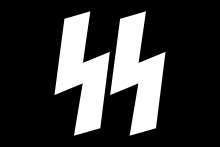Sowilō
Sowilo (*sōwilō) meaning "Sun", is the reconstructed Proto-Germanic language name of the s-rune (ᛊ, ᛋ).
| Name | Proto-Germanic | Old English | Old Norse |
|---|---|---|---|
| *Sōwilō | Sigel | Sól | |
| "Sun" | |||
| Shape | Elder Futhark | Futhorc | Younger Futhark |
| Unicode | ᛊ U+16CA | ᛋ U+16CB | ᛌ U+16CC |
| Transliteration | s | ||
| Transcription | s | ||
| IPA | [s] | ||
| Position in rune-row | 16 | 11 | |
The letter is a direct adoption of Old Italic (Etruscan or Latin) s (𐌔), ultimately from Greek sigma (Σ). It is present in the earliest inscriptions of the 2nd to 3rd century (Vimose, Kovel).
The name is attested for the same rune in all three Rune Poems. It appears as Old Norse and Old Icelandic Sól and as Old English Sigel.
Name
| Look up Reconstruction:Proto-Germanic/sōwulō in Wiktionary, the free dictionary. |
| Look up Reconstruction:Proto-Germanic/sunnǭ in Wiktionary, the free dictionary. |
The Germanic words for "Sun" have the peculiarity of alternating between -l- and -n- stems, Proto-Germanic *sunnon (Old English sunne, Old Norse, Old Saxon and Old High German sunna) vs. *sōwilō or *sōwulō (Old Norse sól, Gothic sauil, also Old High German forms such as suhil). This continues a Proto-Indo-European alternation *suwen- vs. *sewol- (Avestan xweng vs. Latin sōl, Greek helios, Sanskrit surya, Welsh haul, Breton heol, Old Irish suil "eye"), a remnant of an archaic, so-called "heteroclitic", declension pattern that remained productive only in the Anatolian languages.
The Old English name of the rune, written sigel (pronounced /ˈsɪ.jel/) is most often explained as a remnant of an otherwise extinct l-stem variant of the word for "Sun" (meaning that the spelling with g is unetymological),[1] but alternative suggestions have been put forward,[2] such as deriving it from Latin sigillum (assuming that the y is the unetymological element instead).[3]
Development and variants

The Elder Futhark s rune is attested in main two variants, a "Σ shape" (four strokes), more prevalent in earlier (3rd to 5th century) inscriptions (e.g. Kylver stone), and an "S shape" (three strokes), more prevalent in later (5th to 7th century) inscriptions (e.g. Golden horns of Gallehus, Seeland-II-C).
The Younger Futhark Sol and the Anglo-Saxon futhorc Sigel runes are identical in shape, a rotated version of the later Elder Futhark rune, with the middle stroke slanting upwards, and the initial and final strokes vertical.
The Anglo-Saxon runes developed a variant shape (ᚴ), called the "bookhand" s rune because it is probably inspired by the long s (ſ) in Insular script. This variant form is used in the futhorc given on the Seax of Beagnoth.
Rune poems
| Rune Poem:[4] | English Translation: |
|
Old Norwegian
|
|
|
Old Icelandic
|
|
|
Anglo-Saxon
|
|
 Elder Futhark Sowilo rune, earlier ("Σ") variant.
Elder Futhark Sowilo rune, earlier ("Σ") variant. Elder Futhark Sowilo rune, later ("S") variant.
Elder Futhark Sowilo rune, later ("S") variant. Anglo-Saxon Sigel / Younger Futhark Sol rune
Anglo-Saxon Sigel / Younger Futhark Sol rune Anglo-Saxon "bookhand s"
Anglo-Saxon "bookhand s"
Armanen runes

The sig rune in Guido von List's Armanen Futharkh corresponds to the Younger Futhark sigel, thus changing the concept associated with it from "sun" to "victory" (German Sieg).
It was adapted into the emblem of the SS in 1933 by Walter Heck, an SS functionary who worked as a graphic designer for the firm of Ferdinand Hofstätter, a producer of emblems and insignia in Bonn.[5] Heck's design consisted of two sig runes drawn side by side like lightning bolts, and was soon adopted by all branches of the SS, although Heck himself received only a token payment of 2.5 Reichsmarks for his work.[6] Yenne (2010) suggests a double meaning for the device, suggestive of "a rallying cry" of "Victory, Victory!" (see also Sieg Heil).[5] Thus, during the Nazi era, the conventional spelling of Siegrune was adopted, a regular nominal compound translating to "victory rune". The symbol became so ubiquitous that it was frequently typeset using runes rather than letters; during the Nazi period, an extra key was added to German typewriters to enable them to type the double-sig logo with a single keystroke.[7]
See also
- The Lindholm "amulet" that bears the word Sawilagaz which is interpreted as "the one of the Sun"
- Rune poem
- Sigelwara Land
- Sól (Sun)
- SS unit insignia
References
- following Jacob Grimm, Über Diphtongen (1845); see also e.g. Joseph Bosworth, A dictionary of the Anglo-Saxon language (1838), s.v. "Sigel"
- Karl Schneider, Die germanischen Runennamen (1956), p. 98; R. W. V. Elliott, Runes: An Introduction (1981), p. 56; Maureen Halsall, The Old English Rune poem: a critical edition (1981), p. 133.
- Simms, Douglas S.P. (February 23, 2017). "The Old English Name of the S-Rune and "Sun" in Germanic". Journal of Germanic Linguistics. 29 (1): 26–49. doi:10.1017/S1470542716000192.
- Original poems and translation from the Rune Poem Page Archived 1999-05-01 at the Wayback Machine.
- Yenne, Bill (2010). Hitler's Master of the Dark Arts: Himmler's Black Knights and the Occult Origins of the SS. Zenith Imprint. p. 68. ISBN 978-0-7603-3778-3.
- Lumsden, p. 18
- Yenne, p. 71
Further reading
- Huld, Martin E. "Proto- and Post-Indo-European Designations for ‘sun’." Zeitschrift Für Vergleichende Sprachforschung 99, no. 2 (1986): 194-202. www.jstor.org/stable/40848835.
- Wachter, Rudolf. "Das Indogermanische Wort Für 'Sonne' Und Die Angebliche Gruppe Der 1/n-Heteroklitika." Historische Sprachforschung / Historical Linguistics 110, no. 1 (1997): 4-20. www.jstor.org/stable/41288919.